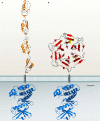Eukaryote-like serine/threonine kinases and phosphatases in bacteria
- PMID: 21372323
- PMCID: PMC3063355
- DOI: 10.1128/MMBR.00042-10
Eukaryote-like serine/threonine kinases and phosphatases in bacteria
Abstract
Genomic studies have revealed the presence of Ser/Thr kinases and phosphatases in many bacterial species, although their physiological roles have largely been unclear. Here we review bacterial Ser/Thr kinases (eSTKs) that show homology in their catalytic domains to eukaryotic Ser/Thr kinases and their partner phosphatases (eSTPs) that are homologous to eukaryotic phosphatases. We first discuss insights into the enzymatic mechanism of eSTK activation derived from structural studies on both the ligand-binding and catalytic domains. We then turn our attention to the identified substrates of eSTKs and eSTPs for a number of species and to the implications of these findings for understanding their physiological roles in these organisms.
Figures






References
-
- Absalon, C., et al. 2009. CpgA, EF-Tu and the stressosome protein YezB are substrates of the Ser/Thr kinase/phosphatase couple, PrkC/PrpC, in Bacillus subtilis. Microbiology 155:932-943. - PubMed
-
- Adler, E., A. Donella-Deana, F. Arigoni, L. A. Pinna, and P. Stragler. 1997. Structural relationship between a bacterial developmental protein and eukaryotic PP2C protein phosphatases. Mol. Microbiol. 23:57-62. - PubMed
-
- Alexander, C., et al. 1995. Phosphorylation of elongation factor Tu prevents ternary complex formation. J. Biol. Chem. 270:14541-14547. - PubMed
Publication types
MeSH terms
Substances
Grants and funding
LinkOut - more resources
Full Text Sources
Other Literature Sources

